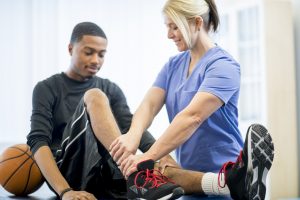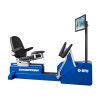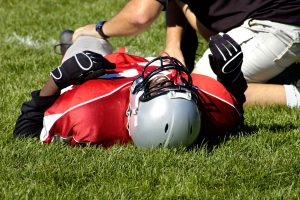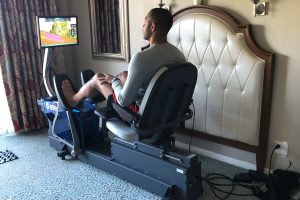
The Missing Achilles Tendon Rupture Protocol
Treatment GuidelinesDespite this high frequency, there is no defined protocol. That’s partly because different surgical procedures require different rehab protocols. Keep reading for the best evidence available and how to safely advance treatment when you don't have access to an established protocol.
An Achilles tendon rupture bothers me to think about more than any other injury. Maybe it’s the memory of my dog biting my Achilles when I was six and knowing how bad it hurt, or maybe it’s the fear of suffering this injury myself. But it makes me have to take a few deep breaths to steady myself when evaluating and treating it.
How Achilles Tendon Ruptures Occur
I love sports, but the downside is the risk of injury, of course. Depending on the activity, age, and gender, sports injuries can vary from minor to life-long effects. An Achilles rupture is fairly common, and unfortunately increasing in occurrence over the last few years. It is now up to a rate of 37 out of 100,000 US citizens1. It mainly affects males between 30-40 years old2.
Surprisingly, the Achilles tendon is the strongest tendon in the body, but it’s the most commonly torn one in the lower extremity. Weekend warriors and elite athletes can suffer a tear as the result of the large biomechanical forces transferring thru the tendon.
These forces typically occur during the eccentric phase where the greatest load is placed through the structure. There could also be other factors that lead to a tear that are hormonal, epidemiological, or the result of medications.
The Achilles Tendon Rupture Rehabilitation Protocol
Despite this high frequency, we don’t have a broad consensus on treatment. There is no defined protocol in existence. That’s partly because different surgical procedures that repair the tendon require different rehabilitation protocols.
Achilles tendon ruptures take a wide range of clinical judgement – from the surgeon, therapist, and the client. Between early rehab and returning to sport or activities, you have a lot of clinical decisions to make. Keep reading for general guidelines on Achilles tendon rupture rehabilitation and what I consider the guiding light to advancing through treatment without a protocol.
Repairing Achilles Tendon Ruptures
Most of the time, Achilles tendon ruptures need surgery to reconnect the tendon. Surgery is most common for those 40 and under, or athletes who need to return to sports. However, many people choose the non-surgical route that requires longer mobilization/casting. This choice carries a higher risk of re-rupture at nearly 40%, while surgery has a lower rate of 1-5%3.
Early Rehab for Achilles Tendon Ruptures
Once the tendon has been surgically repaired, rehabilitation can return the individual back to function or back to sport. In most cases, you should avoid extended mobilization beyond three weeks4. Some literature promotes an aggressive early rehabilitation stage. Immediately following surgery, some recommend full weight bearing at 30° plantar flexion. At the end of the second week, the ankle is then mobilized in plantar flexion and limited dorsiflexion at 0°5.
Continuing Rehab for Achilles Tendon Ruptures
After the first phase of rehab, there is not really a consensus on a single ideal rehabilitation program. Conservative? Aggressive? Those are questions that warrant detailed discussion between the surgeon, therapist, and the client. Movement will progress from isometric strengthening and range of motion exercises to weight bearing, proprioception and more dynamic and functional exercise.
Without a defined protocol, how can you ensure safety and progress while working through the rehab stages? My answer is: objective measurement. If you quantify your measurements, you’ll know exactly when and how much to increase the intensity of exercises. No more guesswork – objective measurement means your clinical decisions are based on real data. You’ll never have to guess whether the client seems stronger or how much their ROM has increased. Simply put, objective measurement is a higher standard of care. Not to mention – clients are usually more engaged when they see their progress expressed in numbers they can understand!
Return to Activity
There is good evidence to support the early return to activity. That activity will consist of active movement with a combination of concentric and eccentric contractions. In the cases of Achilles tendinopathy, eccentric exercise has been shown to be highly effective.
One study compared the use of several rehab techniques for tendinopathies in different joints. These techniques include eccentric exercise, surgery, dry needling, shockwave therapy, splints, platelet rich plasma therapy, laser therapy, ultrasound, iontophoresis, ultrasound guided lavage and corticosteroids. According to the authors…
“ Eccentric exercises were the most common and consistently effective treatment for tendinopathy across systematic reviews. When treating tendinopathy regardless of location, eccentric exercises were the best treatment option to improve tendinopathy-related pain and improve self-reported function. – Irby, et al 2020”
The data showed that each intervention provided some improvement. But eccentric exercise stood out as the most effective treatment method for all joints in the study. Get all the details on this study in our article, Research Shows Eccentric Exercise – Not Needling, Surgery, Splints – Best for Tendinopathy.
Conclusion
In the cases I treated, each young person made a great recovery and returned to sport without issue or reinjury. You too have likely experienced the same. Perhaps, the athletes make our jobs that much easier. As one well known surgeon stated at a conference I attended, It is not I (the surgeon) who is responsible for the success of the return of an athlete to sport; It is the athlete AND that athlete’s own willingness to do the necessary work with their rehabilitation team that will make the difference.
No, there is no “recipe” for treating every person who has an Achilles rupture and subsequent repair. There are however, many ways in which to treat these cases by simply understanding what each client needs to return to function or sport.
Returning to golf, returning to tennis, or the job site will each require a different approach but you have the knowledge at hand to be the difference maker in the successful rehabilitation of your client, no matter their age or activity level!
Jeffrey K Johnson, MA ATC
Clinical Specialist
BTE
References
- Zellers J, Christensen M, Kjaer I, Rathleff M, Silbernagel K. 2019. Defining Components of early Functional Rehabilitation for Acute Achilles Tendon Rupture: A Systematic Review. Orthop J Sports Medicine 7(11).
- Yasui Y, Tonogai I, Rosenbaum AJ, Shimozono Y, Kawano H, Kennedy JG. 2017. The Risk of Achilles Tendon Rupture in the Patients with Achilles Tendinopathy: Healthcare Database Analysis in the United States. Biomed Res Int.
- Lantto I, Heikkinen J, Flinkkila T, Ohtonen P, Siira P, Laine V, Leppilahti J. 2016. A Prospective Randomized Trial Comparing Surgical and Nonsurgical Treatments of Acute Achilles Tendon Ruptures. Am J Sports Med. 44(9):2406-14
- Park S, Lee H, Young K, Seo S. 2020. Treatment of Acute Achilles Tendon Rupture. Clinics in Orthopedic Surgery. 12(1): 1-8.
- Brumann M, Baumbach SF, Mutschler W, Polzer H. 2014. Accelerated rehabilitation following Achilles tendon repair after acute rupture: development of an evidence-based treatment protocol. 45(11):1782–1790
- Freedman B, Gordon J, Soslowsky L. 2014. The Achilles Tendon: fundamental properties and mechanisms governing healing. Muscle, Ligaments and Tendons Journal. April-June 4(2): 245-255.





